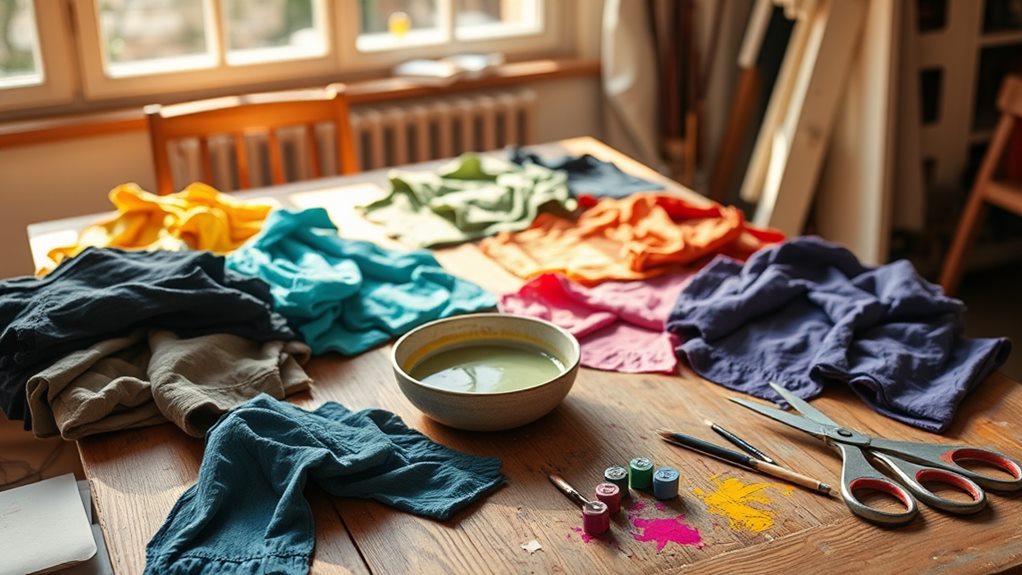You can easily salvage clothes after a bleach stain with some smart DIY fixes. Start by rinsing the affected area under cold water to stop the bleach's damage. For small stains, try using rubbing alcohol or fabric markers to hide the marks. If the stain is large, consider re-dyeing the fabric or creating a tie-dye pattern to transform the look. You can also patch with fabric or doilies for a creative touch. Remember to act fast and explore various methods; there are plenty of innovative solutions waiting to be discovered.
Understanding Bleach Stains
When bleach spills onto your favorite shirt, it can feel like a wardrobe disaster. Understanding bleach stains is vital to prevent and manage the damage effectively. Bleach stains occur when bleach or bleach-containing products strip color from the fabric, leaving behind faded or discolored spots. The severity of this damage varies based on the fabric type, bleach concentration, and duration of exposure.
Cotton, for instance, is particularly susceptible to bleach damage. To minimize environmental impact while caring for your clothes, consider sustainable packaging solutions when purchasing cleaning products.
Immediate action is essential in minimizing the effects of bleach stains. Rinsing the affected area with cold water helps remove excess bleach and prevents further deterioration of the clothing. Once you've rinsed the fabric, consider neutralizing the bleach using a baking soda paste—mix three parts baking soda with one part water. This can help mitigate the damage before you attempt to restore the color.
Different fabrics react uniquely to bleach exposure, so it's important to tailor your approach based on the specific material involved. By understanding bleach stains and taking swift action, you can work towards salvaging your favorite clothing items and avoid permanent loss.
Immediate Actions to Take
When you notice a bleach stain, act fast. Rinse the stained area with cold water to remove excess bleach and prevent further damage.
Utilizing AI-driven tools can help you discover effective fabric care products that prevent stains and maintain your clothes.
Next, create a baking soda paste to neutralize any remaining bleach and protect your fabric.
Rinse With Cold Water
One of the most essential steps to take after a bleach stain occurs is to rinse the affected area with cold water immediately. This action helps remove excess bleach and minimizes further damage to the fabric.
You should rinse the fabric under cold running water for at least 5-10 minutes. This duration allows you to thoroughly dilute and wash away any bleach residues effectively.
Focus on the stained area while rinsing to prevent bleach from spreading to unaffected parts of the garment. Using a clean white cloth or sponge can be beneficial; gently blot the area while rinsing to absorb any remaining bleach solution.
Prompt action within minutes of the bleach exposure considerably increases the chances of successful salvaging.
Neutralize With Baking Soda
After rinsing the bleached area with cold water, it's time to neutralize any remaining bleach to prevent further damage. This step is essential as it minimizes the chances of the bleach causing additional harm to the fibers of your clothing.
To effectively neutralize the bleach, follow these steps:
- Prepare a baking soda paste: Mix three parts baking soda with one part water until you achieve a thick consistency.
- Apply directly to the bleach-stained area: Use a soft cloth or a spatula to spread the paste over the affected fabric.
- Let it dry completely: Allow the paste to sit on the stain until it hardens, then brush it off gently to protect the fabric.
Once you've neutralized the bleach, consider using color restoration techniques to enhance the appearance of your garment.
This process not only helps to remove excess bleach but also aids in reviving the color of your fabric, making it look as good as new.
Techniques for Small Stains
Small bleach stains can be frustrating, but you can often restore your favorite dark fabrics with a few simple techniques. Start by using rubbing alcohol on a cotton wool ball to gently rub around the stain. This helps loosen excess dye, allowing you to restore the original color of your fabric.
Additionally, utilizing expense tracking tools can help you manage costs if you need to replace items. Be sure to rinse the area immediately with cold water to minimize damage and prevent the stain from spreading.
To neutralize bleach, mix a paste of baking soda and water (three parts baking soda to one part water) and apply it to the affected area. This step is essential before attempting any color restoration techniques.
For small bleach spots, fabric markers or laundry pens like Sharpie Rub-a-Dub can effectively cover the stains. Just remember to heat set them by ironing or tumble drying on low.
If you're feeling creative, consider an artistic approach. Use a stamping technique with bleach to create a new design around the stain. Just make sure to neutralize the bleach afterward to prevent further damage.
With these techniques, you can tackle those small bleach stains and give your clothes a fresh lease on life!
Methods for Large Stains
When faced with large bleach stains, you have several effective methods at your disposal to salvage your garment. Reflect on enhancing your approach with effective coupon strategies that can save you money on supplies. Here are three approaches to reflect on:
- Re-dyeing: Use a dye that closely matches your garment's original color. Before applying, use a color remover to eliminate existing dye for a more uniform application, especially if the bleach stains are uneven.
- Lemon Juice Soak: For white clothes, soak the stained area in a solution of 1 cup of lemon juice and 1 gallon of boiling water. This can help restore some color and reduce the visibility of those large bleach stains.
- Tie-Dye Techniques: If you're feeling creative, reflect on using dying techniques like tie-dye. Apply bleach selectively to create patterns, ensuring you protect areas you wish to keep their original color.
If you decide to bleach the entire garment, soak it in cold water first, then neutralize the bleach afterward with hydrogen peroxide to prevent further damage.
These methods can help you rehabilitate your garment and give it a fresh new look!
Creative Cover-Up Ideas
Bleach stains don't have to spell the end for your favorite clothes; instead, they can inspire your creativity. One of the simplest ways to cover those stains is through patching. Consider using vintage fabric doilies or small hexagons to create a decorative patchwork effect that enhances your garment's design.
For a more sustainable approach, look for eco-friendly fabrics that support ethical clothing practices. If the stain is small, Sharpie Rub-a-Dub laundry pens can help with quick touch-ups—just remember to heat fix by ironing or tumble drying on low.
For a more artistic approach, tie-dye techniques can turn bleach stains into unique designs. Use rubber stamps and a bleach-soaked kitchen roll to create patterns that cleverly mask discoloration. Hand sewing patches or decorative embroidery not only hides the damage but also adds a personalized touch, promoting sustainability through creative mending.
Lastly, consider upcycling your stained items into tote bags or quilts. This transforms flaws into fashionable, functional pieces, allowing you to showcase your unique style.
Embrace these creative cover-up ideas, and give your clothes a second life!
Preventing Future Bleach Stains
Preventing future bleach stains starts with a few simple precautions that can save your favorite clothes. By being proactive, you can effectively minimize the risk of damage. Here are three essential steps to follow:
1. Check Care Labels: Always read the care labels before using bleach. Some fabrics are more susceptible to damage, and knowing their specific instructions helps you prevent bleach stains.
Additionally, consider implementing procedures similar to clear payment terms that enhance communication and understanding about laundry practices within your household.
2. Sort Laundry by Color: Keep colored fabrics separate from whites and light colors. Sorting laundry guarantees you avoid accidental bleach exposure that could ruin garments.
3. Communicate with Household Members: Talk to everyone in your home about using bleach. Clear communication helps prevent accidental spills or misuse, which can lead to unwanted stains.
Additionally, when handling bleach, wear old clothes and rubber gloves to protect your skin and garments. Always dilute the bleach with water to minimize the risk of concentrated exposure.
Conclusion
In the world of fashion, a bleach stain can feel like a sudden storm on a sunny day, but it doesn't have to ruin your wardrobe. Just like a skilled artist turns a mistake into a masterpiece, you can transform those pesky stains into unique designs or clever patches. Embrace your creativity and remember, every piece of clothing has a story—even the ones with a little bleach drama. With a bit of effort, you can breathe new life into your favorites!



